Arizona Wild Flowers
Pictures, Photos, Images
Descriptions, Information, Reviews.
Desert Willow, Chilopsis linearis.
We Are Proud Of Our SafeSurf Rating!
 |
| Desert Willow, Chilopsis linearis. Photo Taken June 16, 2003 Near Date Creek, Arizona. |
|---|
 | 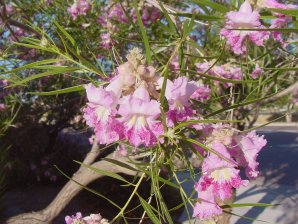 |
| Desert Willow, Chilopsis linearis Upright Shrub Or Small Tree Grows To A Height Of 30 Feet | Spanish Name "Mimbre" Means Willow-Like Not Willow But Species Of The Bigonia Family (Bigoniaceae) |
|---|---|
 |  |
| Large, Fragrant Orchid-Like Flowers, 1-1/4 Inches Long With White Edges And Pink-To-Purple Petals, Throats Yellowish, Bloom From April To September. | Notice The Bright Purple Color This Is A Sign Of A Lot Of Water Available To The Tree |
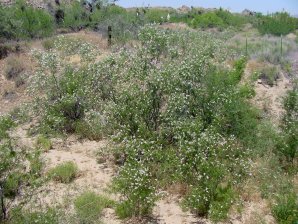 | 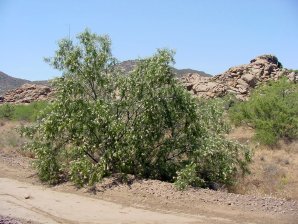 |
| Desert Willow In A Desert Wash. | Desert Willow In Natural Setting. |
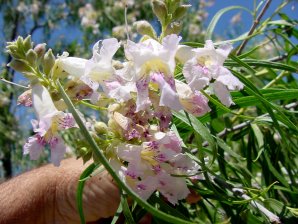 | 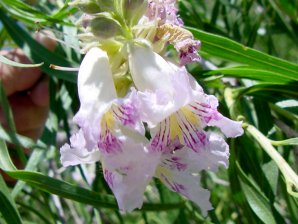 |
| Notice The Lighter Color Of This Flower. That Usually Means Less Available Water. But, It Could Indicate A Sub - Species. | Notice The Lighter Color Of This Flower. That Usually Means Less Available Water. But, It Could Indicate A Sub - Species. |
 /
/

Desert Willow.
We wish to thank Wikipedia, the free encyclopedia for some of the information on this page. We share images and information with Wikipedia. Chilopsis linearis is a small tree native to the southwestern United States and Mexico. The genus Chilopsis, is a genus of flowering plant, containing only one single species, Chilopsis linearis. The Hualapai people of Arizona call it chimov, and the Pima people call it aan. The leaves of Chilopsis linearis are traditionally used by Western Native Americans as an antifungal. The wood is reported to have been used by Western Native Americans for making bows and baskets. Chilopsis linearis is a large deciduous shrub, to small tree. Its long narrow leaves are willow - like. Its flowers are fragrant, pink to lavender. They appear in May and keep blooming until late September or frost. Native near the waterways in the Mojave Desert. It likes moderate water and sun. Does best in the desert. It is easy to grow for landscaping. Though its many common names refer to it as a willow, it is not related to the willow species. Historically the desert willow has been used by the Pima to thatch roofs and for the enjoyment of the pleasant fragrance produced by the plant. This plant is attractive to bees, butterflies and/or birds.
There are two subspecies:
Chilopsis linearis subsp. arcuata. Nevada, California, Baja California.
Quick Notes:
Height: Height to about 30 feet. About 27 feet wide.
Flowers: Terminal clusters with bell or funnel shape; attractive white, lavender, pink, to near-white colors with distinctive yellow throat and venation, they bloom strongest in May-June then sporadically until frost or cold weather.
Flowering Time: Late April to September.
Trunks: Up to about 12 inches thick. Gray brown, lighter colored cracks and splits, later develops shallow furrows and becomes scaly.
Twigs: Slender, initially green turning gray brown, buds are very small.
Seed Pod: Dehiscent Pod, 4 - 9 inches long, they cling on branches throughout the winter.
Seeds: Brown, flat seeds with wings on each end. Seeds are about .03 cm. in size. The wings are fringed with long thin white hairs.
Leaves: Willow like leaves. Simple, solitary, linear, 1/2-3in long, 1/2 to 1/4in wide.
Native: Native to the deserts of the southwestern US, & Baja California in Mexico.
Found: Found throughout Arizona. near waterways and along sandy, dry, washes throughout SW USA and Mexico, Also used as a xeriscape landscape plant..
Hardiness:
Soil pH requirements:
Sun Exposure:
Elevation: 0 - 5,000 Feet.
Habitat: near waterways and along sandy, dry, washes. They thrive in alkaline and saline soils.
Miscellaneous: Flowering Photos Taken In Glendale, Arizona On May 11, 2003. Near Date Creek, Arizona On June 16, 2003.
|
We Are Proud Of Our SafeSurf Rating!
We Are Proud Of Our SafeSurf Rating!
Here Are Some Links To The Very Best & Most Popular Items Sold On Amazon.Com
To Learn More! Click The Links Below. No Obligation, Of Course!



| © 1966 - Present, Audrey, Eve, & George DeLange |


